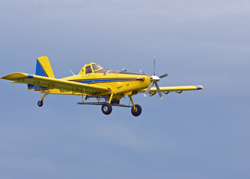 One of the “high”lights of the recent Conservation Technology Information Center tour in Livingston County, Ill., was a demonstration of using a crop duster to seed ground cover on a field still growing corn. Eric Smith with Pontiac Flying Service explained shortly after one of his pilots (in fact, Scott Petersen, the company’s owner/operations manager) flew over the field and buzzed the tents where the tour attendees were standing that putting down the cover of radishes and oats has become a growing aspect of their business.
One of the “high”lights of the recent Conservation Technology Information Center tour in Livingston County, Ill., was a demonstration of using a crop duster to seed ground cover on a field still growing corn. Eric Smith with Pontiac Flying Service explained shortly after one of his pilots (in fact, Scott Petersen, the company’s owner/operations manager) flew over the field and buzzed the tents where the tour attendees were standing that putting down the cover of radishes and oats has become a growing aspect of their business.
“In the aerial application world, you think of fungicide and insecticide work primarily, but we’ve seen an expansion in dry seeding of cover crops and spreading dry fertilizer in a wet year like this year,” Eric said. He went to explain they set up the plane a little differently, using a dry spreader mounted under the hopper and flying a little higher than normal to produce a more uniform seeding pattern over an area. Interest continues to grow for this type of service, with orders already being taken for the fall. “We’re seeing the interest pick up. I know seed supplies were tight last year and I think they’ll be even tighter this year because the demand for this is just exploding.”
Eric went on to point out the advantage of using a plane is that it allows you to get the seed down while the crop is still in the field, giving it a couple of weeks of growth while the cash crop finishes maturing. Plus, he said that root systems on plants such as rye grass have more time to grow and develop root systems.
“We’re excited for our business. It gives us another service we can offer to our customers.”
You can listen to Chuck’s interview with Eric here: [wpaudio url=”http://zimmcomm.biz/ctic/ctic-13-eric-smith.mp3″ text=”Interview with Eric Smith, Pontiac Flying Service”]
